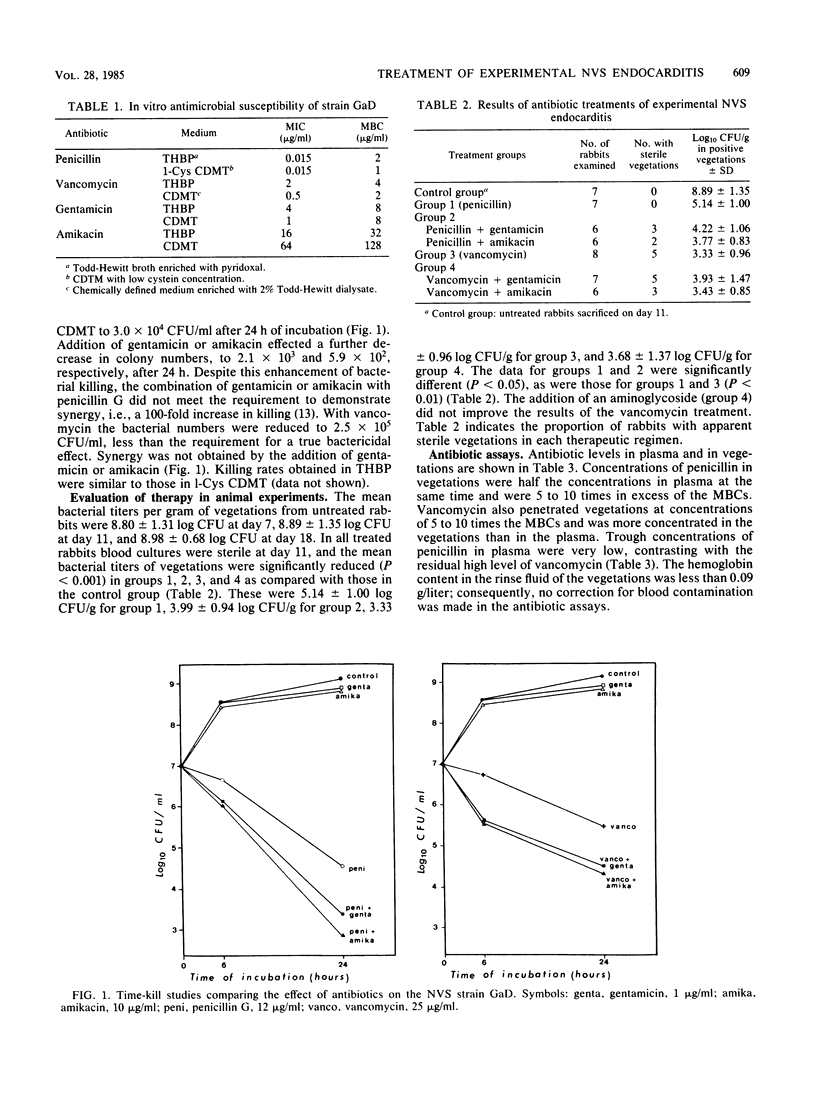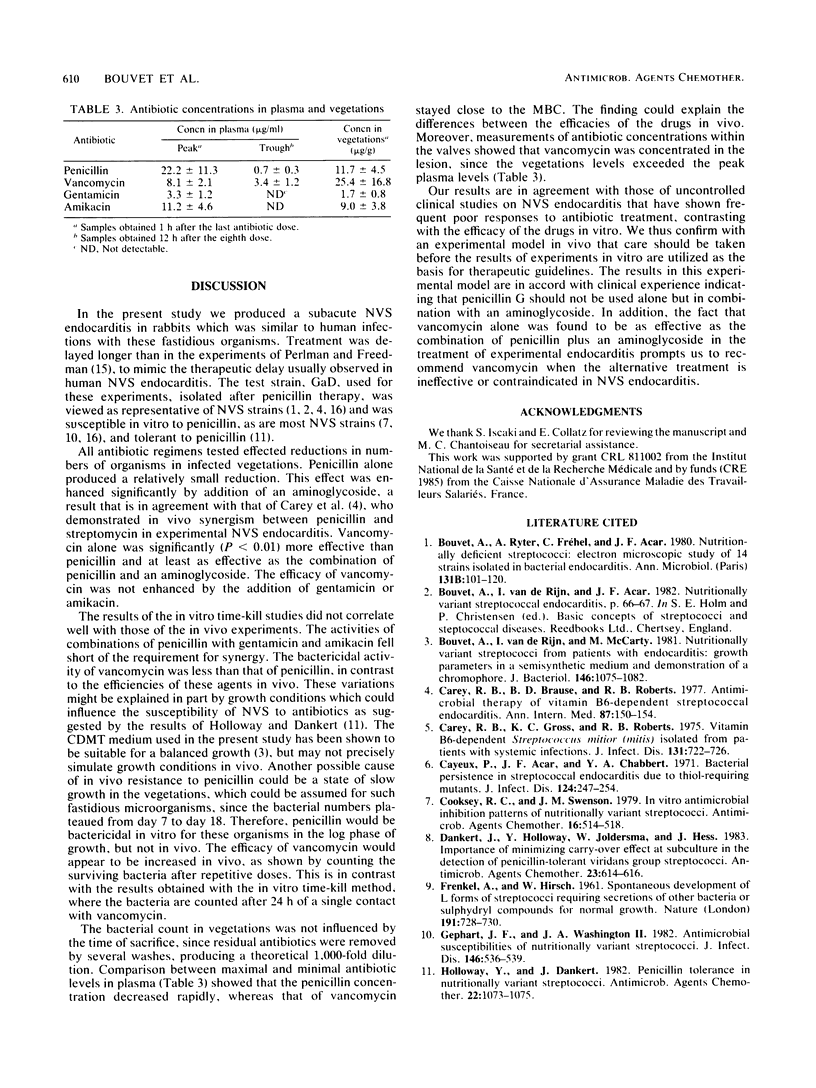Abstract
Six different antibiotic treatment regimens were compared for efficacy in rabbits with endocarditis induced by inoculation with a nutritionally variant strain of streptococcus. Seven untreated animals, sacrificed at day 11, had vegetations containing 8.89 +/- 1.35 log10 CFU/g, none of which was sterile. The vegetations from the rabbits in all treated groups had bacterial titers significantly lower than those of the controls (P less than 0.001). Vegetations from penicillin-treated animals averaged 5.14 +/- 1.00 log CFU/g, and no vegetations were sterile. Treatment with penicillin plus gentamicin or amikacin was more effective than treatment with penicillin alone, resulting in 3.99 +/- 0.94 log CFU/g of vegetation and sterile lesions in 5 of 12 animals. Treatment with vancomycin alone was as least as efficient as that with penicillin plus an aminoglycoside, resulting in an average of 3.33 +/- 0.96 log CFU/g of vegetation and sterile lesions in five of eight animals. Treatment with vancomycin plus an aminoglycoside was not superior to treatment with vancomycin alone, resulting in an average of 3.68 +/- 1.37 log CFU/g of vegetation and sterile lesions in 8 of 13 animals. These in vivo results correlated poorly with the in vitro susceptibility of the strain to the various antibiotics, as measured by the time-kill method. These results support the current practice of using vancomycin as alternative therapy when a penicillin-aminoglycoside combination is ineffective or contraindicated in patients with endocarditis caused by nutritionally variant streptococci.
Full text
PDF




Selected References
These references are in PubMed. This may not be the complete list of references from this article.
- Bouvet A., Ryter A., Fréhel C., Acar J. F. Nutritionally deficient streptococci: electron microscopic study of 14 strains isolated in bacterial endocarditis. Ann Microbiol (Paris) 1980 Sep-Oct;131B(2):101–120. [PubMed] [Google Scholar]
- Bouvet A., van de Rijn I., McCarty M. Nutritionally variant streptococci from patients with endocarditis: growth parameters in a semisynthetic medium and demonstration of a chromophore. J Bacteriol. 1981 Jun;146(3):1075–1082. doi: 10.1128/jb.146.3.1075-1082.1981. [DOI] [PMC free article] [PubMed] [Google Scholar]
- Carey R. B., Brause B. D., Roberts R. B. Antimicrobial therapy of vitamin B6-dependent streptococcal endocarditis. Ann Intern Med. 1977 Aug;87(2):150–154. doi: 10.7326/0003-4819-87-2-150. [DOI] [PubMed] [Google Scholar]
- Carey R. B., Gross K. C., Roberts R. B. Vitamin B6-dependent Streptococcus mitior (mitis) isolated from patients with systemic infections. J Infect Dis. 1975 Jun;131(6):722–726. doi: 10.1093/infdis/131.6.722. [DOI] [PubMed] [Google Scholar]
- Cayeux P., Acar J. F., Chabbert Y. A. Bacterial persistence in streptococcal endocarditis due to thiol-requiring mutants. J Infect Dis. 1971 Sep;124(3):247–254. doi: 10.1093/infdis/124.3.247. [DOI] [PubMed] [Google Scholar]
- Cooksey R. C., Swenson J. M. In vitro antimicrobial inhibition patterns of nutritionally variant streptococci. Antimicrob Agents Chemother. 1979 Oct;16(4):514–518. doi: 10.1128/aac.16.4.514. [DOI] [PMC free article] [PubMed] [Google Scholar]
- Dankert J., Holloway Y., Joldersma W., Hess J. Importance of minimizing carry-over effect at subculture in the detection of penicillin-tolerant viridans group streptococci. Antimicrob Agents Chemother. 1983 Apr;23(4):614–616. doi: 10.1128/aac.23.4.614. [DOI] [PMC free article] [PubMed] [Google Scholar]
- FRENKEL A., HIRSCH W. Spontaneous development of L forms of streptococci requiring secretions of other bacteria or sulphydryl compounds for normal growth. Nature. 1961 Aug 12;191:728–730. doi: 10.1038/191728a0. [DOI] [PubMed] [Google Scholar]
- Gephart J. F., Washington J. A., 2nd Antimicrobial susceptibilities of nutritionally variant streptococci. J Infect Dis. 1982 Oct;146(4):536–539. doi: 10.1093/infdis/146.4.536. [DOI] [PubMed] [Google Scholar]
- Holloway Y., Dankert J. Penicillin tolerance in nutritionally variant streptococci. Antimicrob Agents Chemother. 1982 Dec;22(6):1073–1075. doi: 10.1128/aac.22.6.1073. [DOI] [PMC free article] [PubMed] [Google Scholar]
- Levine J. F., Hanna B. A., Pollock A. A., Simberkoff M. S., Rahal J. J., Jr Penicillin sensitive nutritionally variant streptococcal endocarditis: relapse after penicillin therapy. Am J Med Sci. 1983 Jul-Aug;286(1):31–36. doi: 10.1097/00000441-198307000-00005. [DOI] [PubMed] [Google Scholar]
- Murray P. R., Niles A. C. Inactivation of penicillins by Thiol broth. J Clin Microbiol. 1982 Nov;16(5):982–984. doi: 10.1128/jcm.16.5.982-984.1982. [DOI] [PMC free article] [PubMed] [Google Scholar]
- Perlman B. B., Freedman L. R. Experimental endocarditis. II. Staphylococcal infection of the aortic valve following placement of a polyethylene catheter in the left side of the heart. Yale J Biol Med. 1971 Oct;44(2):206–213. [PMC free article] [PubMed] [Google Scholar]
- Roberts R. B., Krieger A. G., Schiller N. L., Gross K. C. Viridans streptococcal endocarditis: the role of various species, including pyridoxal-dependent streptococci. Rev Infect Dis. 1979 Nov-Dec;1(6):955–966. doi: 10.1093/clinids/1.6.955. [DOI] [PubMed] [Google Scholar]
- Verhaegen J., Vandepitte J. Endocarditis caused by nutritionally deficient streptococci. Acta Clin Belg. 1983;38(1):12–18. doi: 10.1080/22953337.1983.11718900. [DOI] [PubMed] [Google Scholar]
- White L. O., Scammell L. M., Reeves D. S. Serum aminoglycoside assay by enzyme-mediated immunoassay (EMIT): correlation with radioimmunoassay, microbiological assays. Antimicrob Agents Chemother. 1981 Jun;19(6):1064–1066. doi: 10.1128/aac.19.6.1064. [DOI] [PMC free article] [PubMed] [Google Scholar]


